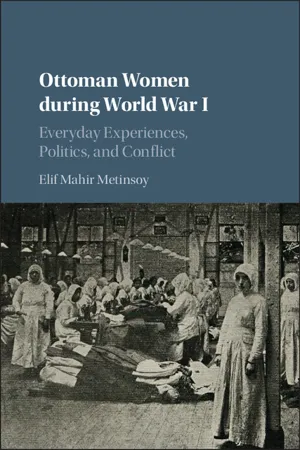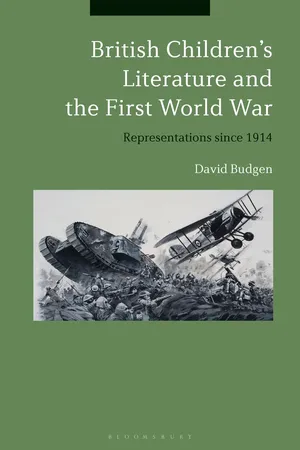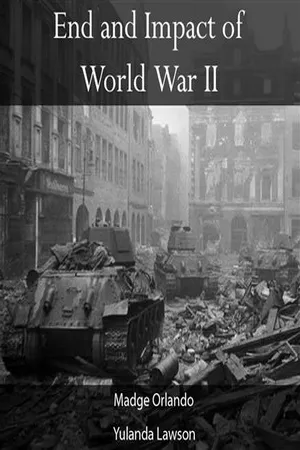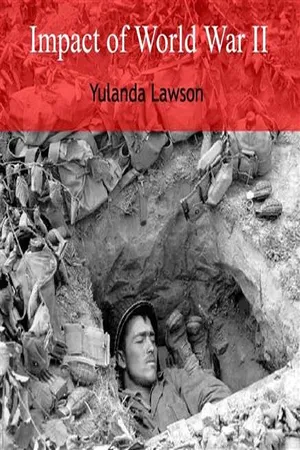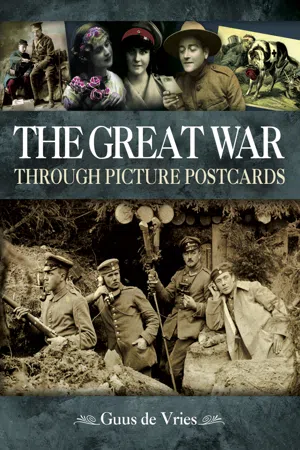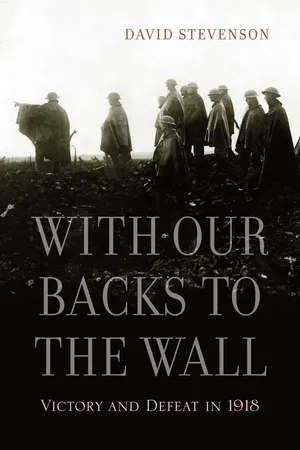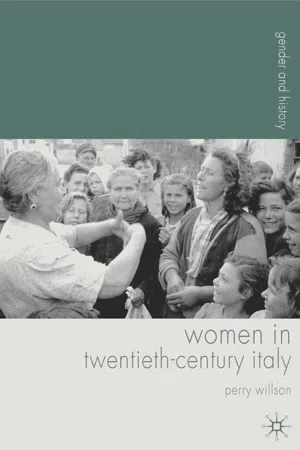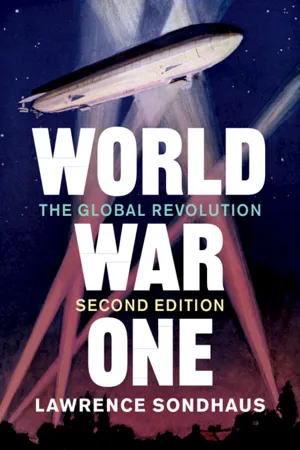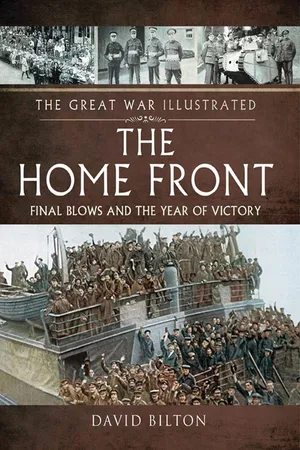History
Homefront WWI
"Homefront WWI" refers to the experiences and activities of civilians in the countries involved in World War I. It encompasses the impact of the war on daily life, including changes in social, economic, and political dynamics. The term also encompasses the various efforts made by civilians to support the war effort, such as rationing, fundraising, and working in industries to aid the war.
Written by Perlego with AI-assistance
Related key terms
1 of 5
12 Key excerpts on "Homefront WWI"
- Roger Chickering(Author)
- 2014(Publication Date)
- Cambridge University Press(Publisher)
The toll taken on Allied soldiers in German captivity thus reflected broader problems from which German civilians were not spared. Home front and battle front The home front and the fighting front were inextricably married. 24 The performance of the German armies in the field defined the central man- date of civilian efforts, and it affected the material circumstances of civil- ian life at home. The impact of war on the home front was less immediate than on the front lines, simply because of the distances that separated civilians from the fighting; but the experience of war at home was no less massive or comprehensive. The home front and the fighting front were also linked in constant communication. The attempt of the censors to police this link met with only mixed success, for numerous channels of communication kept civilians and soldiers abreast of one another’s fortunes. The direct experience of war on the German home front did not match the terrors of the next European conflict, although there were several exceptions to the rule. Germans in the southeastern parts of East Prussia endured several hard months of Russian occupation in the fall of 1914. Apart from small areas in Alsace, the west remained unoccupied until war’s end; but the western front ran close enough to the border in several places that German civilians experienced the sights and sounds of com- bat. Residents of towns and villages in the upper Rhine region, in Baden, could hear and see artillery exchanges along the Alsatian sector of the front, which ran along the crest of the Vosges Mountains. Residents in a number of west German cities, such as D¨ usseldorf, Cologne, Mainz, Strassburg, Mannheim, and Karlsruhe, received a foretaste of the next war in a series of bombing raids by French and British airplanes, which operated out of eastern France.- eBook - ePub
America and World War I
A Selected Annotated Bibliography of English-Language Sources
- David Woodward(Author)
- 2013(Publication Date)
- Routledge(Publisher)
V Home Front
A. General and Comparative Sources
(See also V:F:1, Entente; V:F:2, Central Powers)993. Cashman, Sean Dennis. America in the Age of the Titans: The Progressive Era and World War I . New York: New York University Press, 1988. 605 pp.Although lacking footnotes and marred by numerous errors this survey is still useful for its broad coverage.994. Chambers, Frank P. The War Behind the War 1914–1918: A History of the Political and Civilian Fronts . New York: Arno Press, 1972. 620 pp.Where can the World War I historian turn to find the ministers and their respective responsibilities in the numerous French wartime governments or a concise summary of Belgium under German occupation? The answer to this and many other questions concerning the home front can be found in this comprehensive account, which succeeds admirably in its ambitious task of surveying the political, social, and economic conditions of the major belligerents. This is a reprint of the 1939 edition.995. Churchill, Allen. Over Here!: An Informal Re-Creation of the Home Front in World War I . New York: Dodd, Mead, 1968. 240 pp.This is a general, popular work on the American home front during the Great War. This volume is well written, but it is obviously based on secondary sources and adds nothing new to the historiography of the home front. The author does not include documentation.996. Eisner, Marc Allen. From Warfare State to Welfare State: World War I, Compensatory State Building, and the Limits of the Modern Order . University Park: Pennsylvania State University Press, 2000. 371 pp.The title of this book well describes Eisner’s thesis. Eisner finds the antecedents of the New Deal in many government programs and actions to mobilize the home front for total war. The wartime regulation of agriculture and the activities of the Council on National Defense and the War Industries Board are emphasized.997. Ellis, Edward Robb. Echoes of Distant Thunder—Life in the United States, 1914–1918 - eBook - PDF
Ottoman Women during World War I
Everyday Experiences, Politics, and Conflict
- Elif Mahir Metinsoy(Author)
- 2017(Publication Date)
- Cambridge University Press(Publisher)
Part I The Home Front 1 Women in Europe and the United States Despite the huge burden that the war brought to their lives, women’s entry into jobs left by men during World War I and the political rights women acquired during or after the war have long been considered as evidence of their “emancipation.” However, the changing roles of men and women during the war years were reversed quickly after the war with the emergence of pronatalist politics, authoritarian-conservative states, and the demand by society to return to “normalcy.” According to Françoise Thébaud, the lack of studies on countries other than the United States and those in western Europe also enforces the idea that the war liberated women as a whole. 1 Therefore, reaching a more realistic picture requires comparing the situation of women in these countries with that of Ottoman women. However, it is necessary to know first of all the distinct nature of World War I. The First “Total War” Many historians consider World War I to have been the first “total war.” 2 Unlike the “limited wars” of the nineteenth century, which required smaller armies, World War I was almost limitless in terms of its destruc- tiveness, social impact, and mobilization of economic sources and human power. 3 All of the powerful imperial countries and all of the European countries, except for Spain, Holland, Switzerland, Denmark, Norway, and Sweden, entered into the war. 4 Whereas the social impact of previous wars was much more limited to the battlefield, at the onset of the twentieth century, war became “total” and brought about a new concept of “home front” as a civilian sphere upon which the combatants fought. It was on this front where other sorts of battles for propaganda, mobilization, and maintenance of social order occurred. 5 The development of new weapons, transportation vehicles, and com- munication techniques in the nineteenth century transformed World War I into a mass warfare. - eBook - PDF
British Children's Literature and the First World War
Representations since 1914
- David Budgen(Author)
- 2018(Publication Date)
- Bloomsbury Academic(Publisher)
Those authors writing before the Second World War had tended to concentrate on the experience of either combat or adventures set around the front lines. During this period, the home front had simply been the starting point for the protagonists’ adventures, while the few exceptions were often aimed at a young female audience. In short, fiction of the war years focused on the abnormalities of wartime Britain, and not the experience of everyday life. This changed after the Second World War. Post-1945 depictions of the Great War utilized the home front setting more frequently. The massive social upheaval brought about by the two world wars contributed to the shift towards such narratives. As the First World War increasingly came to be seen as a historical aberration, its representations in popular culture came to reflect and inform public understandings of the conflict. Moreover, in academia, the scope of historical research was increasing; social and cultural histories of the conflict became more important. This led to different understandings of both world wars, and affected popular perceptions of the conflicts. More modern depictions of the home front during the First World War seem to have been partially inspired by the more recent experiences of the Second World War. Modern writers and audiences had developed a greater understanding of the importance of the home front in wartime. Indeed, this perception of British society – often exploited by propagandists – had a long-lasting effect on popular memory; the ‘spirit of the Blitz’, for example, is still invoked at times of crisis. 1 During the First World War, society had focused on those who had borne the brunt of the loss and suffering: military personnel. Civilians came more to the forefront in the Second World War. That war’s greatest horrors –invasion, occupation, genocide – had not physically affected the British people. - No longer available |Learn more
- (Author)
- 2014(Publication Date)
- College Publishing House(Publisher)
________________________ WORLD TECHNOLOGIES ________________________ Chapter 11 Home Front during World War II U.S. Government Publicity photo of American machine tool worker in Texas The home front covers the activities of the civilians in a nation at war. World War II was a total war, homeland production became even more invaluable to both the Allied and Axis powers. Life on the home front during World War II was a significant part of the war effort for all participants and had a major impact on the outcome of the war. Governments became involved with new issues such as rationing, manpower allocation, home defense, evacuation in the face of air raide, and response to occupation by an enemy power. The morale and psychology of the people responed to leadership and ________________________ WORLD TECHNOLOGIES ________________________ propaganda. Typically women were mobilized to an unprecedented degree. The success in mobilizing economic output was a major factor in supporting combat operations. Overview The major powers devoted 50 –61% of their total GDP to munition production. The Allies produced about three times as much in munitions as the Axis powers. Munitions Production in World War II (Expenditures in billions of dollars, US 1944 munitions prices) Country/Alliance Year 1935-9 ave 1940 1941 1942 1943 1944 Total 1939–44 U.S.A. 0.3 1.5 4.5 20.0 38.0 42.0 106.3 Britain 0.5 3.5 6.5 9.0 11.0 11.0 41.5 U.S.S.R 1.6 5.0 8.5 11.5 14.0 16.0 56.6 Allies Total 2.4 10.0 20.0 41.5 64.5 70.5 204.4 Germany 2.4 6.0 6.0 8.5 13.5 17.0 53.4 Japan 0.4 1.0 2.0 3.0 4.5 6.0 16.9 Axis Total 2.8 7.0 8.0 11.5 18.0 23.0 70.3 Source: Goldsmith data in Harrison (1988) p. - No longer available |Learn more
- (Author)
- 2014(Publication Date)
- Research World(Publisher)
________________________ WORLD TECHNOLOGIES ________________________ Chapter-5 Home Front during World War II U.S. Government Publicity photo of American machine tool worker in Texas. The home front covers the activities of the civilians in a nation at war. World War II was a total war, homeland production became even more invaluable to both the Allied and Axis powers. Life on the home front during World War II was a significant part of the war effort for all participants and had a major impact on the outcome of the war. ________________________ WORLD TECHNOLOGIES ________________________ Governments became involved with new issues such as rationing, manpower allocation, home defense, evacuation in the face of air raide, and response to occupation by an enemy power. The morale and psychology of the people responed to leadership and propaganda. Typically women were mobilized to an unprecedented degree. The success in mobilizing economic output was a major factor in supporting combat operations. Overview The major powers devoted 50–61% of their total GDP to munition production. The Allies produced about three times as much in munitions as the Axis powers. Munitions Production in World War II (Expenditures in billions of dollars, US 1944 munitions prices) Country/Alliance Year 1935-9 ave 1940 1941 1942 1943 1944 Total 1939–44 U.S.A. 0.3 1.5 4.5 20.0 38.0 42.0 106.3 Britain 0.5 3.5 6.5 9.0 11.0 11.0 41.5 U.S.S.R 1.6 5.0 8.5 11.5 14.0 16.0 56.6 Allies Total 2.4 10.0 20.0 41.5 64.5 70.5 204.4 Germany 2.4 6.0 6.0 8.5 13.5 17.0 53.4 Japan 0.4 1.0 2.0 3.0 4.5 6.0 16.9 Axis Total 2.8 7.0 8.0 11.5 18.0 23.0 70.3 Source: Goldsmith data in Harrison (1988) p. - eBook - ePub
- Guus de Vries(Author)
- 2020(Publication Date)
- Pen & Sword Military(Publisher)
Chapter 12 The Home Front and the Neutral States O ne reason why the First World War is called a total war is the fact that it was not only fought on the battlefield, but also had far reaching effects on the political, economic and social development of the warring countries and even those of the neutral states. Politics and the Economy In many European countries the interior situation was marked by schisms and contradictions, often fuelled by the rise of socialist and social democratic parties. When war broke out these political differences were, however, almost immediately buried in favour of national unity. Emperor Wilhelm II announced before the German Reichstag: ‘Henceforth I know no parties, I know only Germans’ and the so-called ‘ Burgfrieden ’ (originally a medieval concept of keeping peace inside the castle walls) was made. In France the President called on the parties to form a union sacrée and in the UK the suffragettes paused their campaign for equal (political) rights for women until further notice. These demonstrations of national unity would be universally maintained until the end of the war. Ranks were closed not only politically, but the population was also asked to contribute to the national war effort on an economic level. Immediately after the outbreak of the war, the French president addressed his public appeal to the female population (Aux femmes Françaises), asking them to take over the work on the farms and bring in the harvest in the autumn. This was only the first in a number of drastic but unavoidable measures, as the military side of war had been carefully planned in terms of the mobilisation and deployment of armies numbering millions, but economical preparations for the war had hardly been given a thought. There were few stocks and supplies and no plans to integrate civilian factories into the defence industry. In addition, many workers and engineers in leading positions had been drafted and were at the front - eBook - PDF
With Our Backs to the Wall
Victory and Defeat in 1918
- David Stevenson(Author)
- 2011(Publication Date)
- Belknap Press(Publisher)
439 7 The Home Fronts: Gender, Class, and Nation Of all the problems which Governments had to handle during the Great War, the most delicate and most perilous were those arising on the home front . . . David Lloyd George 1 Whenever I think of the War today, it is not as summer but always as winter; always as cold and darkness and discomfort, and an intermittent warmth of exhilarating excitement which made us irrationally exultant in all three. Its perennial symbol for me is a candle stuck in the neck of a bottle, its tiny flame flickering in an ice-cold draught yet creating a miniature illusion of light against an opaque infinity of blackness. Vera Brittain 2 In 1918 the Central Powers were not only defeated militarily: they were also convulsed politically. Revolution overthrew the Hohenzollern mon-archy, Austria-Hungary broke up, King Ferdinand of Bulgaria abdicated, and the Young Turk party left government and dissolved itself. Military defeat set the collapse in motion, but internal upheaval completed it. Yet when the war began it had been far from obvious that the Allies could better withstand a prolonged struggle. Italy was socially polarized, and the Catholic Church as well as the Left and liberal progressives opposed its intervention. Pre-1914 France had been riven by the Dreyfus Affair and over rearmament, while Britain had suffered vicious party strife, unprecedented labour unrest, the most militant women’s suffrage cam-paign in Europe, and the threat of civil war in Ireland. Nevertheless – with Russia the glaring exception – the Allies outlasted their opponents, and 440 With Our Backs to the Wall liberal political systems proved more resilient than their authoritarian rivals. The emphasis here will be on the wellsprings of that resilience, on gender, the working-class and the Left, and nationalism and the Right, before concluding with leadership. Gender Without co-operation from millions of women, neither side could have continued fighting. - eBook - ePub
- Perry Willson(Author)
- 2009(Publication Date)
- Bloomsbury Academic(Publisher)
3On the ‘Home Front’: World War One and its Aftermath, 1915–20
Many historians have concluded that wars are limited in their ability to emancipate women. They may open up new roles but these are usually temporary. Wars may appear to subvert the gender order, but, with peace, it is restored, often with a vengeance. Periods of warfare often bring an exaltation of traditional gender roles with men portrayed as warriors and women as mothers, symbolic guardians of peace, normality and the home, which soldiers protect by their fighting and can return to when hostilities end. Indeed, the Higonnets have argued, invoking the image of the ‘double helix’ to explain the enduring constancy of gender differentiation in wartime, that, in both world wars, women only stepped temporarily into the ‘male sphere’. Meanwhile male activities were still construed as socially more important.1 This idea, which suggests no real change at all, is perhaps too rigid, although it does have resonances for the Italian experience. As for other countries, the issues are complex. In Italy, some, albeit fairly limited, change brought by World War One did outlive the ending of hostilities and there were opportunities for women to prove their worth in both paid employment and voluntary work. But lasting change was limited.For Italy, the Great War was a traumatic event that both forged and revealed the inadequacies of national identity.2 Italy joined the war in 1915 after prolonged, heated debate about whether to intervene, a debate that tore the nation apart and created a rift along which post-war politics would later align. Although Italy did eventually decide to fight (alongside France and Britain), after a sustained campaign by a minority of extremely vocal ‘interventionists’, many Italians remained opposed to going to war. Italy’s war experience was terrible for soldiers but generally better for civilians compared with the Second World War. In the Great War, the battlefront and ‘home front’ were quite distinct: few non-combatants actually witnessed the fighting. The only exceptions were those living near the front lines or in parts of the Veneto invaded by the Austrians after the defeat of Caporetto in 1917. Here women experienced some of the horrors of war. In the occupied territory, as the research for a post-war Royal Commission revealed, rapes, including terrible incidents of drunken gang-raping, or of very young girls or elderly women, were common.3 - eBook - PDF
World War One
The Global Revolution
- Lawrence Sondhaus(Author)
- 2020(Publication Date)
- Cambridge University Press(Publisher)
The Home Fronts, 1916–18 11 January 1916 Military Service Act authorizes conscription in Britain. April 1916 Ireland’s Easter Rising. Autumn 1916 Hindenburg Program militarizes German war industries. November 1916 Emperor Francis Joseph dies. December 1916 Lloyd George becomes British prime minister. January 1917 London press makes first reference to “flappers.” April 1917 Stockholm Conference of anti-war socialists (to January 1918). May 1917 Selective Service Act authorizes conscription in the United States. July 1917 German Reichstag passes Peace Resolution. October 1917 Orlando becomes Italian prime minister, introduces rationing. November 1917 Clemenceau becomes French premier, introduces rationing. January 1918 War’s worst strikes cripple Germany and Austria-Hungary. January 1918 Britain initiates food rationing. March 1918 Representation of the People Act enfranchises British women. March 1918 Influenza pandemic begins. the home fronts, 1916–18 286 During the last half of the war, the European powers with the greatest capacity to wage modern war each experienced serious crises on their home fronts. Britain resorted to conscription and suppressed a rebellion in Ireland. France endured a crisis of home-front morale mirroring that of the army and a collapse of the union sacrée, with the war still far from being won. Germany likewise experienced the collapse of the Burgfrieden, coinciding with the unprecedented militarization of its home front under the Hindenburg Program and the struggle to feed the civilian population during the “turnip winter.” Among the weaker great powers, Austria- Hungary appeared doomed to follow Russia down the path of disintegration, as rev- olutionary thinking spread among its nationalities following the death of Francis Joseph, while in Italy, as in France, the collapse of the army’s morale threatened the home front as well. - eBook - PDF
Australians and the First World War
Local-Global Connections and Contexts
- Kate Ariotti, James E. Bennett, Kate Ariotti, James E. Bennett(Authors)
- 2017(Publication Date)
- Palgrave Macmillan(Publisher)
Such sources might not offer unmediated access to some authentic sensibility about the issues at hand. Rather, they reveal the ways in which civilians made sense of the war and expressed their relationships to it. Those relationships were intimate: in their studies of French soldiers’ writing, Martyn Lyons and Martha Hanna have both emphasised the process of mutual support conducted between the fronts, in which “intimacy—though sometimes strained by absence and anxiety—remained alive.” 24 The potent connections between the home front and the battlefront are critical to understanding total war as the domain of citizens as much as soldiers, as Michael Roper has shown. 25 Yet a consideration of civilians’ own accounts of home front life also remains pressing. Part of the problem is that civilians’ letters have not survived in anything like the numbers of soldiers’ letters available to us. They are not entirely absent, however, and Christa Hämmerle reminds us ‘TOTAL WAR’ IN AUSTRALIA . . . 171 that questions remain to be answered about civilians and their efforts to endure the demands of war: How did these men and women act under the auspices of a public opinion permeated and distorted by war propaganda? How did they cope in their letters with the antagonistic tension between their own private needs and the expectations of their nation at war? 26 Such questions demand a concerted effort at interrogating civilian experi- ence through their own works. As with military personnel who used their letters and diaries to give order to their experiences, to contain them and negotiate their meaning with those from whom they were separated, so we can begin to uncover how individuals existed in wartime society, and how they negotiated private and public imperatives through their own writing. - eBook - PDF
The Home Front
Final Blows and the Year of Victory
- David Bilton(Author)
- 2020(Publication Date)
- Pen and Sword Military(Publisher)
The Home Fronts in 1918 Stick it! ‘A s 1917 turned into 1918, the problems remained the same and would do so for some time. There were shortages of food and men for the army, prices were rising, and there was in-dustrial unrest and air raids to deal and contend with. Apart from final victory there was to be one other high point of the coming year, the granting of the vote to many women.’ In the forty-nine months since the war had started, much had changed. Around the world everyone fervently hoped the war would end but no one was really prepared for such a dramatic change as the end of the greatest war ever fought. While the Allies were preparing for victory in 1919, the Germans were preparing for the war to end in 1918, now Russia was no longer an issue; but ‘there’s many a slip ‘twixt cup and lip’ – a thought indicated in June when Ludendorff said that the war could last longer than planned. For Germany, prospects were dark unless a quick victory was achieved. Economic life was threatened with paralysis through lack of coal, oils and lubricants and the breakdown of the railways. The Allies could rely on vast manpower reinforcements from America while Germany’s manpower resources were virtually exhausted. While the combatants readied themselves for yet another year of war, and the Home Fronts got ready to tighten their belts even further, the arrival of large numbers of American troops was set to change the outcome. President Wilson, even though a newcomer to the war, addressed Congress in January with his fourteen points for peace, adding a further five points in September. The Reading Chronicle introduced the New Year with serious words: ‘Whether 1918 will end the war may be uncertain.
Index pages curate the most relevant extracts from our library of academic textbooks. They’ve been created using an in-house natural language model (NLM), each adding context and meaning to key research topics.


